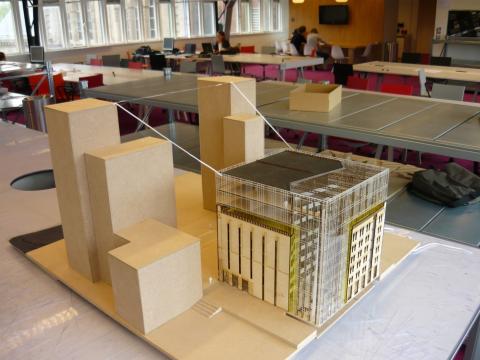Using Laser Cutters in Architecture Class

Thursday, September 6, 2019
Laser cutters offer architecture students a unique opportunity to see their ideas quickly and precisely move from paper to miniature versions of reality. Whether a student’s creation is a home, downtown development, bridge, railway or architectural flourish, laser cutters offer tremendous advantages for three-dimensional fabrication.
Once a plan is in place — an idea has made the transfer from brain to paper — it can move from two dimensions to three through computer-aided design (CAD). Using CAD enables architects to view different aspects and perspectives of a building within the context of a single platform. Architecture students often design and develop with traditional drawing media in the early stages, followed by further refinement in an application such as AutoCAD and then full, virtual realization in a 3D modeling program such as SketchUp.
By converting CAD files into file types a laser cutter can read, students are able to build a physical model of their creations which allows them to further examine their stability and practicality. The laser cuts with precision and detail, providing an exact — albeit much smaller — version of each piece of a project. After cutting, those pieces can be assembled without the need for further post-processing. The laser cuts every component of the model — roof planes, exterior walls, ground planes, columns and beams — into compact puzzle-like pieces that can be glued together to make the final model.
In addition to bringing students’ ideas into the physical world, lasers significantly reduce production time for cutting components thanks to their speed and power. As a result more students can use the machinery. Oftentimes, the device becomes one of a school’s most popular and versatile pieces of equipment.
Because laser cutters are so fast and powerful they can reliably cut through a wide range of materials. Any material that is typically used for cutting and engraving architectural models can be used in a laser cutter, including textiles, synthetic materials, wood, veneer, medium-density fiberboard (MDF), cardboard, paper, foam, polystyrene, acrylics (PMMA), and plastics. That kind of flexibility offers budding architects the potential to create realistic models that cannot be achieved with other technologies.
Laser cutters can help bring a project from idea to fruition. Not all ideas can be reproduced exactly as they are initially conceived; building models helps determine the strengths, weaknesses and overall viability of an idea. The laser’s speed and precision allow students to refine their ideas quickly, helping them to identify and pursue realistic projects from the earliest stages of the design process. This can reduce students’ potential for frustration and conserve their valuable time and resources.
Seen in this light, it’s clear that laser cutters are a tool that architecture students can use to help them succeed in their chosen profession.
Source: www.epiloglaser.com[/vc_column_text][/vc_column][/vc_row]









 This content was provided by Epilog Laser. In business since 1988, Epilog Laser has worked hard to become the leader in the laser engraving, cutting and marking industry. We are innovators. We are problem solvers. We are committed to designing and manufacturing the highest-quality laser systems, right here in our Golden, CO headquarters.
This content was provided by Epilog Laser. In business since 1988, Epilog Laser has worked hard to become the leader in the laser engraving, cutting and marking industry. We are innovators. We are problem solvers. We are committed to designing and manufacturing the highest-quality laser systems, right here in our Golden, CO headquarters.







